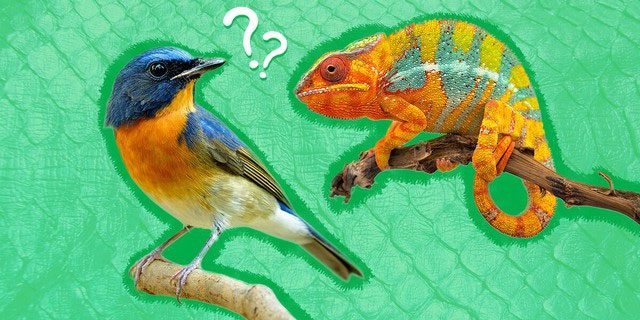When we think of reptiles, we often picture scaly creatures like lizards or crocodiles slithering through swamps or wetlands. However, few people realize that birds, with their entirely different appearance, also belong to the reptile group.
All species of birds, lizards, crocodiles, and other reptiles evolved from a single common ancestor. This indicates that reptiles are more closely related to each other on the evolutionary tree than to any other type of animal.
We have solid fossil evidence showing that birds evolved from dinosaurs. When imagining reptiles, we usually think of long bodies, shiny scales, and forked tongues. These images do not evoke feelings of lightness or friendliness. In contrast, the light and bright feathers, along with the sweet chirping of birds, conjure thoughts of flowers, flying, and large flocks decorating the blue sky. Thus, linking birds with reptiles is not an easy task.

According to Carolus Linnaeus, birds and reptiles belong to two different groups.
The question of whether birds are reptiles is a matter of classification. Carolus Linnaeus, the founder of modern biological classification, concluded that birds and reptiles belong to two different groups.
Linnaeus’s classification approach was entirely based on the characteristic physical traits of animals or plants. We refer to these as phenotypic traits: anything observable from the appearance of an organism is a trait or phenotype expressed. According to Linnaeus, birds and lizards are too different in appearance and behavior to be considered relatives.
Besides appearance, birds and reptiles also lack common physiological traits. Reptiles are cold-blooded or ectothermic, while birds are warm-blooded or endothermic. Ectothermic animals regulate their internal body temperature by using heat from the environment. In contrast, endothermic animals maintain a constant internal body temperature by producing heat through bodily processes. However, some reptile species exhibit endothermic behavior in specific situations. For instance, female pythons shiver to generate heat for incubating their eggs.

Evolutionary tree
Both birds and reptiles lay eggs, although many species of snakes give live birth. Yet, it is clear that classifying birds and reptiles based solely on physical or physiological traits is not entirely accurate. We need to follow the evolutionary tree to better understand the relationship between these two groups.
We can draw analogous lines not horizontally, but vertically, tracing the ancestors of the two groups of organisms. A prime example is the common ancestor between modern humans and chimpanzees, from which we then diverged into current forms. When asking “Are birds truly reptiles?”, we must investigate when and how reptiles and birds emerged in their distinct current forms.
We know that dinosaurs and crocodiles are the ancient ancestors of lizards and that modern birds appeared after them. The group Archosaurs, which includes dinosaurs, lizards, turtles, and the ancestors of birds, has existed since the time of early dinosaurs.
The fossil record over decades has revealed that the origins of current reptiles trace back to the first crocodiles that lived on Earth around 350 million years ago and that dinosaur species began roaming the Earth 100 million years later.

The oldest known bird is believed to be Epidexipteryx, followed by Archaeopteryx.
A subgroup within Archosaurs, known as Theropods, became the true ancestors of modern birds. These dinosaurs were among the first to develop wings and feathers. A notable example of a winged Theropod is Archaeopteryx. When the first Archaeopteryx fossil was discovered in 1860, it sparked a series of theories leading to the confirmation that birds are evolved dinosaurs.
The discovery of the Xiaotingia Zhengi fossil in 2011 in China identified it as an earlier relative of birds compared to Archaeopteryx. The most recent findings indicate that the oldest known bird is Epidexipteryx. Scientists have published studies on this pigeon-sized dinosaur, which had bright feathering resembling ribbons, likely not for flying but perhaps to maintain balance on tree branches.
The question arises as to why a thriving group of terrestrial reptiles chose to evolve to soar through the skies. One hypothesis suggests that these reptiles may have developed or evolved longer forelimbs with feathers to help them easily climb up and down cliffs and mountains. The evolution of feathers may have initially helped them survive in landscapes for purposes other than flying, such as moving more efficiently. Utilizing aerodynamics to assist in navigating difficult terrains seems like a clear advancement.

Birds have undergone a complex and fascinating evolutionary process.
The final evidence supporting the claim that birds evolved from dinosaurs is the high metabolic rate and rapid growth of dinosaurs. Cold-blooded reptiles typically have lower metabolic rates and slower growth compared to warm-blooded birds and mammals. Scientists have suggested that such bodily activities can only mean one thing – dinosaurs were gradually developing the ability to maintain their body temperature for various tasks, while also potentially adapting to their environment. This phenomenon is known as facultative endothermy.
Birds, although regarded as reptiles, have undergone a complex and fascinating evolutionary process to become the flying creatures we see today. From a common ancestor with other reptiles, birds have developed unique and distinct characteristics, making them a special group of organisms in the animal kingdom. This not only clarifies the evolutionary relationships among species but also opens up many new questions and explorations regarding the diversity and evolution of life on Earth.


















































